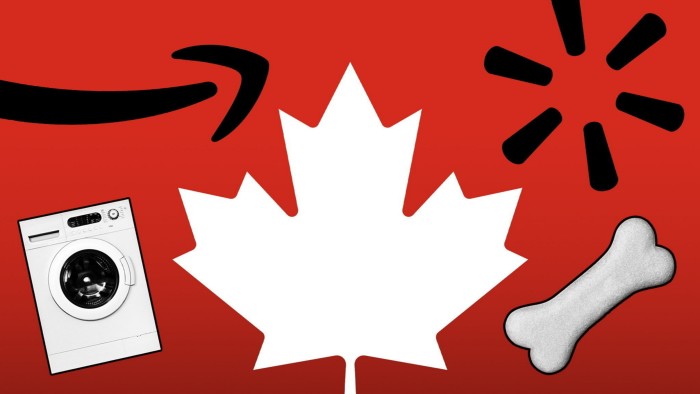Unlock the Editor’s Digest for free
Roula Khalaf, Editor of the FT, selects her favourite stories in this weekly newsletter.
Amazon and Walmart’s third-party sellers are hoarding stock in Canada as they try to wait out President Donald Trump’s trade war with China.
Independent vendors who sell products — from cheap dog toys to appliances — through the companies’ US ecommerce platforms are shifting goods from China to Canadian warehouses, according to half a dozen sellers, logistics providers and consultants.
Several makers and distributors of Amazon’s and Walmart’s own products, as well as suppliers to companies such as Disney, are also using the tactic, some of the people said.
The moves have been spurred by sweeping tariffs imposed by Trump’s administration on China, whose trades with the US face levies as high as 145 per cent.
The Canadian stalling tactic — which takes advantage of tariff-exempt warehouses, tax reliefs and rebates — will add between $500-$600 per container in costs for sellers, and represents a bet that the White House will back down on the steep tariffs on China.
“If we trust the US administration . . . [and] that’s still a big if, this is the worst it’s going to get. And so we’re prepared to wait this out,” said one senior executive at a major third-party seller on Amazon and Walmart.
“This is not going to last for ever,” the executive added.
Both Amazon and Walmart sell goods directly and host third-party retailers. More than 60 per cent of the Seattle-based group’s sales are through third parties. The proportion is much lower for Walmart.
Retailers have been seeking routes to mitigate tariffs as they continue to work with suppliers and brands on shifting the manufacturing of popular items to countries where the tariff burden is lower, including India and Vietnam.
Manufacturers have warned that this process, which was already under way following pressure from successive US administrations, will still take several years.
Meanwhile, sellers and suppliers are grappling with what to do with orders that are already en route, and how to prepare for the critical sales period in the lead-up to Christmas.
One option is to use bonded warehouses in the US, where inventory can be stored duty-free up to five years. But they are in short supply.

Canada allows warehouse operators to apply for exemptions from duties in so-called foreign-trade zones, which can include bonded warehouses. Sellers can also apply for relief or a refund on Canadian duties provided goods are exported within four years.
Flexport, a US logistics group, said there were early signs that shipments were being routed to Canada after it observed a 50 per cent increase in consignments from China to the country last week.
Stashing goods in Canada could also help retailers avoid paying sky-high shipping costs if tariffs are ultimately lowered, said Kara Babb, a vendor consultant and former Amazon vendor manager.
Amazon and Walmart declined to comment.
Nathan Strang, ocean freight director at Flexport, said the practice of stowing stock in Canada added cost and could backfire if vendors and sellers were forced to import products into the US while the tariffs on China were still in place.
“It could wind up being an added expense on top of a tariff that you’re going to have to pay anyway,” Strang said.
Dean Wood, chief executive of BorderWorx Logistics, which specialises in US-Canada logistics and warehousing, said that some retailers were willing to absorb the additional cost associated with importing into Canada as it was still cheaper than paying the current rate of US tariffs.
“It’s a cash flow challenge, but it’s still very valuable for companies that are hedging their bets,” Wood added.




